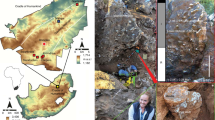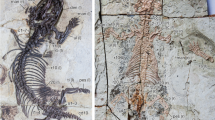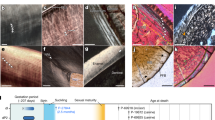Abstract
Transformations in morphology, physiology and behaviour along the mammalian stem lineage were accompanied by profound modifications to reproduction and growth, including the emergence of a reproductive strategy characterized by high maternal investment in a small number of offspring1,2 and heterochronic changes in early cranial development associated with the enlargement of the brain3. Because direct fossil evidence of these transitions is lacking, the timing and sequence of these modifications are unknown. Here we present what is, to our knowledge, the first fossil record of pre- or near-hatching young of any non-mammalian synapsid. A large clutch of well-preserved perinates of the tritylodontid Kayentatherium wellesi (Cynodontia, Mammaliamorpha) was found with a presumed maternal skeleton in Early Jurassic sediments of the Kayenta Formation. The single clutch comprises at least 38 individuals, well outside the range of litter sizes documented in extant mammals. This discovery confirms that production of high numbers of offspring represents the ancestral condition for amniotes, and also constrains the timing of a reduction in clutch size along the mammalian stem. Although tiny, the perinates have an overall skull shape that is similar to that of adults, with no allometric lengthening of the face during ontogeny. The only positive allometries are associated with the bones that support the masticatory musculature. Kayentatherium diverged just before a hypothesized pulse of brain expansion that reorganized cranial architecture at the base of Mammaliaformes4,5,6. The association of a high number of offspring and largely isometric cranial growth in Kayentatherium is consistent with a scenario in which encephalization—and attendant shifts in metabolism and development7,8—drove later changes to mammalian reproduction.
This is a preview of subscription content, access via your institution
Access options
Access Nature and 54 other Nature Portfolio journals
Get Nature+, our best-value online-access subscription
$29.99 / 30 days
cancel any time
Subscribe to this journal
Receive 51 print issues and online access
$199.00 per year
only $3.90 per issue
Buy this article
- Purchase on Springer Link
- Instant access to full article PDF
Prices may be subject to local taxes which are calculated during checkout





Similar content being viewed by others
References
Hopson, J. A. Endothermy, small size, and the origin of mammalian reproduction. Am. Nat. 107, 446–452 (1973).
Case, T. J. On the evolution and significance of postnatal growth rates in vertebrates. Q. Rev. Biol. 53, 243–282 (1978).
Koyabu, D. et al. Mammalian skull heterochrony reveals modular evolution and a link between cranial development and brain size. Nat. Commun. 5, 3625 (2014).
Rowe, T. B. Definition, diagnosis, and origin of Mammalia. J. Vert. Paleont. 8, 241–264 (1988).
Liu, J. & Olsen, P. The phylogenetic relationships of Eucynodontia (Amniota: Synapsida). J. Mamm. Evol. 17, 151–176 (2010).
Rowe, T. B., Macrini, T. E. & Luo, Z.-X. Fossil evidence on origin of the mammalian brain. Science 332, 955–957 (2011).
Sacher, G. A. & Staffeldt, E. F. Relation of gestation time to brain weight for placental mammals: implications for the theory of vertebrate growth. Am. Nat. 108, 593–615 (1974).
Martin, R. D. Relative brain size and basal metabolic rate in terrestrial vertebrates. Nature 293, 57–60 (1981).
Kermack, D. M. A new tritylodontid from the Kayenta Formation of Arizona. Zool. J. Linn. Soc. 76, 1–17 (1982).
Sues, H.-D. First record of the tritylodontid Oligokyphus (Synapsida) from the Lower Jurassic of western North America. J. Vert. Paleont. 5, 328–335 (1985).
Sues, H.-D. Skull and dentition of two tritylodontid synapsids from the Lower Jurassic of western North America. Bull. Mus. Comp. Zool. 151, 217–268 (1986).
Hill, J. P. V. The development of the Monotremata. Part II. The structure of the egg-shell. Trans. Zool. Soc. Lond. 24, 443–456 (1933).
Sander, P. M. Reproduction in early amniotes. Science 337, 806–808 (2012).
Mock, D. W. & Parker, G. A. The Evolution of Sibling Rivalry (Oxford Univ. Press, Oxford, 1998).
Sánchez-Villagra, M. R. Developmental palaeontology in synapsids: the fossil record of ontogeny in mammals and their closest relatives. Proc. R. Soc. Lond. B 277, 1139–1147 (2010).
Jasinoski, S. C. & Abdala, F. Aggregations and parental care in the Early Triassic basal cynodonts Galesaurus planiceps and Thrinaxodon liorhinus. PeerJ 5, e2875 (2017).
Regnault, S., Hutchinson, J. R. & Jones, M. E. H. Sesamoid bones in tuatara (Sphenodon punctatus) investigated with X-ray microtomography, and implications for sesamoid evolution in Lepidosauria. J. Morphol. 278, 62–72 (2017).
Regnault, S. & Hutchinson, J. R. Sesamoid bones in tuatara. Open Science Framework https://osf.io/bds35/ (2017).
Young, N. M. et al. Embryonic bauplans and the developmental origins of facial diversity and constraint. Development 141, 1059–1063 (2014).
Wealthall, R. J. & Herring, S. W. Endochondral ossification of the mouse nasal septum. Anat. Rec. 288A, 1163–1172 (2006).
Cardini, A. & Polly, P. D. Larger mammals have longer faces because of size-related constraints on skull form. Nat. Commun. 4, 2458 (2013).
Jasinoski, S. C., Abdala, F. & Fernandez, V. Ontogeny of the Early Triassic cynodont Thrinaxodon liorhinus (Therapsida): cranial morphology. Anat. Rec. (Hoboken) 298, 1440–1464 (2015).
Crompton, A. W. & Parker, P. Evolution of the mammalian masticatory apparatus. Am. Sci. 66, 192–201 (1978).
Rowe, T. Coevolution of the mammalian middle ear and neocortex. Science 273, 651–654 (1996).
Kuhne, W. G. The Liassic therapsid Oligokyphus (British Museum, London, 1956).
Hu, Y., Meng, J. & Clark, J. M. A new tritylodontid from the Upper Jurassic of Xinjiang, China. Acta Palaeontol. Pol. 54, 385–391 (2009).
Crompton, A. W. Postcanine occlusion in cynodonts and tritylodontids. Bull. Br. Mus. 21, 27–71 (1972).
Cui, G. & Sun, A. Postcanine root system in tritylodonts. Vertebrata Palasiatica 25, 245–259 (1987).
Luo, Z.-X., Gatesy, S. M., Jenkins, F. A. Jr, Amaral, W. W. & Shubin, N. H. Mandibular and dental characteristics of Late Triassic mammaliaform Haramiyavia and their ramifications for basal mammal evolution. Proc. Natl Acad. Sci. USA 112, E7101–E7109 (2015).
Richardson, M. K. et al. Heterochrony in limb evolution: developmental mechanisms and natural selection. J. Exp. Biol. 312B, 639–664 (2009).
Weisbecker, V. Monotreme ossification sequences and the riddle of mammalian skeletal development. Evolution 65, 1323–1335 (2011).
Rieppel, O. Studies on skeleton formation in reptiles. V. Patterns of ossification in the skeleton of Alligator mississippiensis Daudin (Reptilia, Crocodylia). Zool. J. Linn. Soc. 109, 301–325 (1993).
Rieppel, O. Studies on skeleton formation in reptiles: patterns of ossification in the skeleton of Chelydra serpentina (Reptilia, Testudines). J. Zool. (Lond.) 231, 487–509 (1993).
Rieppel, O. Studies on skeleton formation in reptiles. I. The postembryonic development of the skeleton in Cyrtodactylus pubisulcus (Reptilia: Gekkonidae). J. Zool. (Lond.) 227, 87–100 (1992).
Carter, D. R., Mikić, B. & Padian, K. Epigenetic mechanical factors in the evolution of long bone epiphyses. Zool. J. Linn. Soc. 123, 163–178 (1998).
Sues, H.-D. & Jenkins, F. A. in Amniote Paleobiology: Perspectives on the Evolution of Mammals, Birds, and Reptiles (eds Carrano, M. T. et al.) 114–152 (Chicago Univ. Press, Chicago, 2006).
Ray, S., Bandyopadhyay, S. & Bhawal, D. Growth patterns as deduced from bone microstructure of some selected neotherapsids with special emphasis on dicynodonts: phylogenetic implications. Palaeoworld 18, 53–66 (2009).
Kemp, T. S. The relationships of mammals. Zool. J. Linn. Soc. 77, 353–384 (1983).
Rowe, T. B. in Evolution of Nervous Systems 2 Vol. 2 (ed. Kaas, J.) 1–52 (Academic, Oxford, 2017).
R Core Team. R: A Language and Environment for Statistical Computing https://www.R-project.org/ (R Foundation for Statistical Computing, Vienna, 2017).
Warton, D. I., Duursma, R. A., Falster, D. S. & Taskinen, S. smatr 3–an R package for estimation and inference about allometric lines. Methods Ecol. Evol. 3, 257–259 (2012).
Acknowledgements
We thank A. Zaman and B. Niessemeyer of the Navajo Nation Minerals Division for issuing the permit (dated 27 March 2000) under which this specimen was collected, and K. Calsoyas and T. Anderson for promoting our collaboration with the Navajo EcoScouts Program. Funding was provided by the National Science Foundation (EAR 1561622, IIS-9874781), by the Geology Foundation of The University of Texas and by the Jackson School of Geosciences. We thank B. Andres, S. Egberts, J. Franzosa, R. Gary, E. Gordon, T. Macrini, P. Owen, C. Sagebiel and R. S. Wallace for field, laboratory and curatorial assistance; M. Colbert, J. Maisano, J. Berlin and G. Rogers for computed tomography scanning the specimens described here; and S. Regnault, J. Hutchinson, C. Bell and digimorph.org for Sphenodon computed tomography scans.
Reviewer information
Nature thanks H. Sues, L. Wilson and the other anonymous reviewer(s) for their contribution to the peer review of this work.
Author information
Authors and Affiliations
Contributions
T.B.R. directed collecting and preparation of the specimen. E.A.H. performed measurements, quantitative analyses and segmentation of computed tomography data, assembled comparative reproductive data and prepared the figures and tables. E.A.H. and T.B.R. wrote the manuscript and Supplementary Information.
Corresponding author
Ethics declarations
Competing interests
The authors declare no competing interests.
Additional information
Publisher’s note: Springer Nature remains neutral with regard to jurisdictional claims in published maps and institutional affiliations.
Extended data figures and tables
Extended Data Fig. 1 Preparation and scanning of specimen (TMM 43690-5).
a, Field jacket next to quarry, set on 8-foot-long, 2-by-4-inch beams; the red object on top is a Swiss army knife. b, Scanning the opened jacket at the Austin Heart Hospital. S. Egberts (right) discovered the perinates. c, d, Photomicrograph of a right mandible (TMM 43690-5.135d) (c) exposed on the surface of a ‘chunk’ of matrix removed from the opened jacket (d). At this stage of preparation, the jacket still contained maternal bones (black outline) as well as some perinatal remains. e, f, Chunk of matrix (TMM 43690-5.135) removed from jacket for high-resolution computed tomography scanning. g, Volumetric rendering of a sub-volume scan of the chunk showing a maternal thoracic vertebra surrounded by perinatal bones. h, Small chunk (TMM 43690-5.013) with flecks of perinatal bone exposed on the surface. i, j, Digital radiograph (i) of multiple flakes mounted in lucite tube for reconnaissance scan, and computed tomography slice (j), at level indicated by red line in i, showing perinatal remains (red circles). k, l, Computed tomography scanning (k) of individual chunk (TMM 43690-5.013), and high-resolution computed tomography slice (l) showing perinatal bones and components of the sediment. b, perinatal bones; c, carpals; cl, clay clast; M1, M2, lower molariforms 1, 2; n, carbonate nodule; ph, phalanges; r, ribs; s, sand matrix; sc, scapula; u, ulna.
Extended Data Fig. 2 Selected perinatal remains.
a, Perinatal bones. b, Original positions of bones in a with respect to adult elements. Yellow stars indicate perinatal individuals that preserve paired dentaries and that were counted towards our census; green stars indicate parts of perinatal individuals that were not counted towards our census (or counted as one-half; Extended Data Table 1a, Supplementary Table 1). Because stars are larger than perinatal bones, the positions of the stars are approximate. c, Chunk of original matrix showing adult thoracic vertebra and selected perinatal remains in situ. Matrix is rendered transparent. The vertebra in c corresponds to that shown in b. Specimen numbers 2, 3, 5, 6, 8, 10, 14 and 15 correspond to TMM 43690-5.135a–TMM 43690-5.135h; specimen numbers 4, 7, 9, 12 and 13 correspond to TMM 43690-5.136a–TMM 43690-5.136e; specimen number 11 corresponds to TMM 43690-5.137a; and specimen number 1 corresponds to TMM 43690-5.139a. c, carpus; I1, lower incisor; M1, M2, lower molariforms 1, 2; M1, first upper molariform; mc, metacarpal; ph, phalanges; r, rib; u, ulna; v, vertebra.
Extended Data Fig. 3 Skull ontogeny in Kayentatherium.
The log–log plot shows various skull measurements versus maximum skull length at up to three ontogenetic stages (perinate, small adult and large adult). Because sample sizes are low, lines connecting the data points are shown in place of regression lines. The reference line has a slope or coefficient of allometry, b, equal to 1. In analyses of allometry, b < 1 indicates negative allometry and b > 1 indicates positive allometry. Raw data are in Extended Data Table 1c. Skulls shown are TMM 43690-5.035a, MCZ 8811 and MCZ 8812.
Extended Data Fig. 4 Mandibular and dental ontogeny in Kayentatherium.
a–c, Ontogenetic series of right Kayentatherium dentaries in lateral view (a, perinate, TMM 43690-5.035b; b, small adult, MCZ 8811; c, large adult, MCZ 8812). Curves follow the angle of the coronoid process at its base and stars indicate the anterior limit of the masseteric fossa. Jaws on the left are shown relative to the large adult, MCZ 8812.
Extended Data Fig. 5 Dental and mandibular anatomy of Kayentatherium perinate (TMM 43690-5.035b).
a, Right dentary in lateral view. b, Teeth in dorsal view in situ without dentary. c, Right dentary in medial view. I1, lower incisor; I1r, replacement lower incisor; M1–M4, lower molariforms 1–4.
Extended Data Fig. 6 Postdentary elements of Kayentatherium perinate (TMM 43690-5.032a).
a, Partial left mandible in medial view, with postdentary elements coloured red. b, Section through coronoid process and postdentary elements at position indicated in a. c, Partial right mandible in medial view. M1–M3, lower molariforms 1–3.
Extended Data Fig. 7 Additional views of hand and forelimb of Kayentatherium perinate (TMM 43690-5.032a).
a, Partial left hand in situ with paired jaws, carpals, humerus and additional fragmentary elements. b, Partial left hand in palmar view. I–V, digits I–V.
Extended Data Fig. 8 Additional views of humerus and femur of Kayentatherium perinates.
a–d, Humerus (TMM 43690-5.032a) in frontal (a, b) and side (c, d) views. e–h, Femur (TMM 43690-5.013a) in frontal (e, f) and side (g, h) views.
Supplementary information
Supplementary Information
This file includes information on the geology, taphonomy, and discovery of the site; scanning information; explanation of body-mass estimation and supplementary references.
Supplementary Table 1
Census of perinatal individuals.
Supplementary Table 2
Amniote clutch/litter size and hatchling/neonate mass.
Video 1
3D roll of block containing multiple perinates (TMM 43690-5.136a–e) in association with adult carpus and metacarpal, with and without matrix.
Video 2
3D roll of block containing multiple perinates (TMM 43690-5.035a–e), with and without matrix.
Video 3
3D roll of block containing perinatal skull and jaw (TMM 43690-5.045a), with and without matrix.
Video 4
3D roll of perinatal (TMM 43690-5.017a) and adult upper molariforms.
Video 5
3D roll of perinatal (TMM 43690-5.017a) and adult lower molariforms.
Video 6
3D yaw of perinatal skull (TMM 43690-5.035a).
Video 7
3D roll of perinatal skull (TMM 43690-5.035a).
Video 8
Frontal clip through perinatal skull (TMM 43690-5.035a).
Rights and permissions
About this article
Cite this article
Hoffman, E.A., Rowe, T.B. Jurassic stem-mammal perinates and the origin of mammalian reproduction and growth. Nature 561, 104–108 (2018). https://doi.org/10.1038/s41586-018-0441-3
Received:
Accepted:
Published:
Issue Date:
DOI: https://doi.org/10.1038/s41586-018-0441-3
Keywords
This article is cited by
-
Reptile-like physiology in Early Jurassic stem-mammals
Nature Communications (2020)
-
The Evolution of the Maxillary Canal in Probainognathia (Cynodontia, Synapsida): Reassessment of the Homology of the Infraorbital Foramen in Mammalian Ancestors
Journal of Mammalian Evolution (2020)
-
How the earliest mammals thrived alongside dinosaurs
Nature (2019)
Comments
By submitting a comment you agree to abide by our Terms and Community Guidelines. If you find something abusive or that does not comply with our terms or guidelines please flag it as inappropriate.



